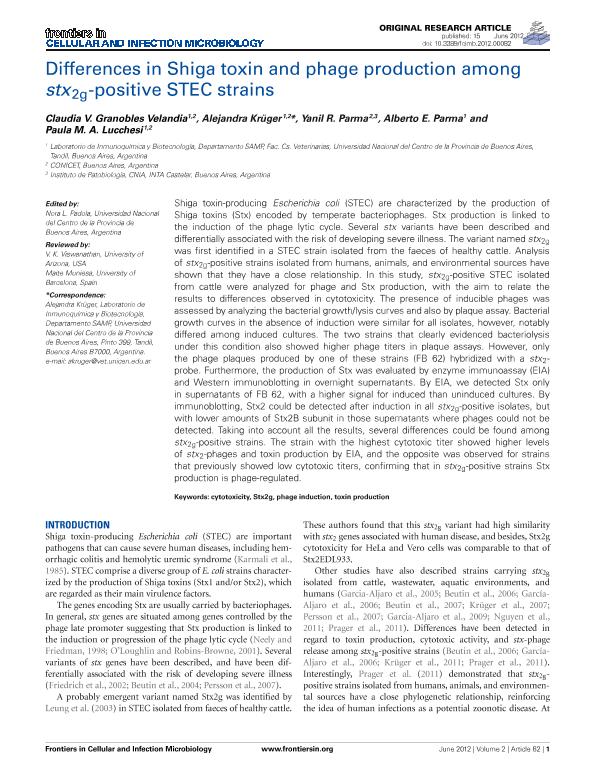Artículo
Differences in Shiga toxin and phage production among stx2g-positive STEC strains
Granobles Velandia, Claudia Viviana ; Krüger, Alejandra
; Krüger, Alejandra ; Parma, Yanil Renee
; Parma, Yanil Renee ; Parma, Alberto Ernesto
; Parma, Alberto Ernesto ; Lucchesi, Paula Maria Alejandra
; Lucchesi, Paula Maria Alejandra
 ; Krüger, Alejandra
; Krüger, Alejandra ; Parma, Yanil Renee
; Parma, Yanil Renee ; Parma, Alberto Ernesto
; Parma, Alberto Ernesto ; Lucchesi, Paula Maria Alejandra
; Lucchesi, Paula Maria Alejandra
Fecha de publicación:
06/2012
Editorial:
Frontiers Research Foundation
Revista:
Frontiers in Cellular and Infection Microbiology
ISSN:
2235-2988
Idioma:
Inglés
Tipo de recurso:
Artículo publicado
Clasificación temática:
Resumen
Shiga toxin-producing Escherichia coli (STEC) are characterized by the production of Shiga toxins (Stx) encoded by temperate bacteriophages. Stx production is linked to the induction of the phage lytic cycle. Several stx variants have been described and differentially associated with the risk of developing severe illness. The variant named stx2g was first identified in a STEC strain isolated from the faeces of healthy cattle. Analysis of stx2g-positive strains isolated from humans, animals, and environmental sources have shown that they have a close relationship. In this study, stx2g-positive STEC isolated from cattle were analyzed for phage and Stx production, with the aim to relate the results to differences observed in cytotoxicity. The presence of inducible phages was assessed by analyzing the bacterial growth/lysis curves and also by plaque assay. Bacterial growth curves in the absence of induction were similar for all isolates, however, notably differed among induced cultures. The two strains that clearly evidenced bacteriolysis under this condition also showed higher phage titers in plaque assays. However, only the phage plaques produced by one of these strains (FB 62) hybridized with a stx2-probe. Furthermore, the production of Stx was evaluated by enzyme immunoassay (EIA) and Western immunoblotting in overnight supernatants. By EIA, we detected Stx only in supernatants of FB 62, with a higher signal for induced than uninduced cultures. By immunoblotting, Stx2 could be detected after induction in all stx2g-positive isolates, but with lower amounts of Stx2B subunit in those supernatants where phages could not be detected. Taking into account all the results, several differences could be found among stx2g-positive strains. The strain with the highest cytotoxic titer showed higher levels of stx2-phages and toxin production by EIA, and the opposite was observed for strains that previously showed low cytotoxic titers, confirming that in stx2g-positive strains Stx production is phage-regulated.
Palabras clave:
Cytotoxicity
,
Stx2g
,
Phage Induction
,
Toxin Production
Archivos asociados
Licencia
Identificadores
Colecciones
Articulos(CIVETAN)
Articulos de CENTRO DE INVESTIGACION VETERINARIA DE TANDIL
Articulos de CENTRO DE INVESTIGACION VETERINARIA DE TANDIL
Citación
Granobles Velandia, Claudia Viviana; Krüger, Alejandra; Parma, Yanil Renee; Parma, Alberto Ernesto; Lucchesi, Paula Maria Alejandra; Differences in Shiga toxin and phage production among stx2g-positive STEC strains; Frontiers Research Foundation; Frontiers in Cellular and Infection Microbiology; 2; 6-2012; 1-5; 82
Compartir
Altmétricas



